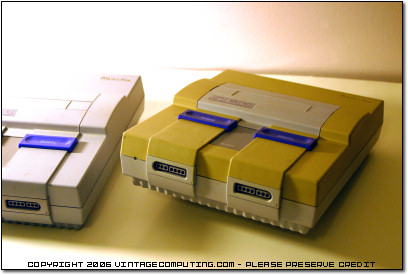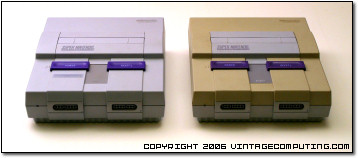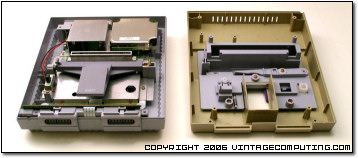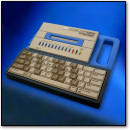
Sure, consoles age and get dirty. Heck, I remember a suspicious incident involving my Super Nintendo (SNES) console and a can of Coca-Cola in the early ’90s that left my SNES looking more like a moldy loaf of bread than a video game system. But around five years ago, I noticed that my SNES console was aging particularly badly. I cleaned off all the remnants of fossilized Coke residue from the chassis with a wet washcloth, but the “moldy bread” look still remained. The top half of the console’s plastic body retained a uniformly nasty yellow-brown hue, while the bottom half flaunted its showroom shine — that native SNES gray that we all know and love. I soon realized that a much deeper mechanism was responsible for the aesthetic disfigurement of my beloved SNES than mere dirt and sugar.
To further complicate matters, I have another SNES unit that was obviously produced more recently than my original one, and that console shows no sign of aging whatsoever. Comparing the units and the way different parts of them had discolored led me to believe that there is something different about the two batches of plastics — the one for the top half of the SNES chassis and the one for the bottom, or the plastic for the old unit and plastic for the new — that made them age differently over time.
Immediately below are two photos I took of my actual SNES units. Notice the difference between the colors of the top and bottom halves of the plastic chassis on the older unit, and also how the newer unit shows no sign of discoloration at all.
 My first SNES console (right) exhibits discoloration on the top half only.
My first SNES console (right) exhibits discoloration on the top half only.
The newer unit on the left, however, looks as good as new.
 The top half and bottom half of my first SNES console, disassembled.
The top half and bottom half of my first SNES console, disassembled.
Notice that the underside is yellowed with the same uniformity as the top.
[ Continue reading Why Super Nintendos Lose Their Color: Plastic Discoloration in Classic Machines » ]


 The two most popular news agencies have published no less than two articles in the last two days about vintage computers. Are the planets in alignment, or does there now exist a vast conspiracy (the conspiracy of “twos” perhaps?) to cover vintage computers in the national media? Either way, it’s been a great week for our hobby.
The two most popular news agencies have published no less than two articles in the last two days about vintage computers. Are the planets in alignment, or does there now exist a vast conspiracy (the conspiracy of “twos” perhaps?) to cover vintage computers in the national media? Either way, it’s been a great week for our hobby.






 I had already been collecting computers for at least two years when I saw the machine, and I was always on the lookout for more additions to my collection. I had heard of a little-known machine called the “Lisa” that Apple released somewhere between the Apple III and the Macintosh, but I had never seen or used one. So when I spotted the Lisa in the library that day, it was an epiphany to me — the Apple story was vividly coming together in my brain. Knowing that the Lisa (a Lisa 2, as it turned out) in the school library was obsolete, I feared that the librarians wouldn’t know what to do with it and would throw it away. I had to take action, but I was painfully shy, and I was only about thirteen or fourteen years old. I was afraid to ask them about the computer because I figured they wouldn’t take me seriously. So I convinced my mother (the best mom ever) to drive back to the library after school and ask the librarians if we could buy the Lisa from them. The librarians had to decline the offer, since it had been donated to the library and was property of the county school system. Sadly, I fear that the Lisa in the library probably met a nasty fate not too long after that incident — a victim of short-sighted middle school bureaucracy.
I had already been collecting computers for at least two years when I saw the machine, and I was always on the lookout for more additions to my collection. I had heard of a little-known machine called the “Lisa” that Apple released somewhere between the Apple III and the Macintosh, but I had never seen or used one. So when I spotted the Lisa in the library that day, it was an epiphany to me — the Apple story was vividly coming together in my brain. Knowing that the Lisa (a Lisa 2, as it turned out) in the school library was obsolete, I feared that the librarians wouldn’t know what to do with it and would throw it away. I had to take action, but I was painfully shy, and I was only about thirteen or fourteen years old. I was afraid to ask them about the computer because I figured they wouldn’t take me seriously. So I convinced my mother (the best mom ever) to drive back to the library after school and ask the librarians if we could buy the Lisa from them. The librarians had to decline the offer, since it had been donated to the library and was property of the county school system. Sadly, I fear that the Lisa in the library probably met a nasty fate not too long after that incident — a victim of short-sighted middle school bureaucracy. In
In 





